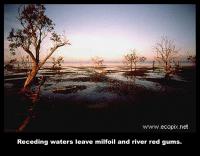Mine water use apparently ignored in water crisis
Aboriginal elders and environmental activists are calling for mining in the Lachlan Catchment of New South Wales to be halted as the Wyangala Dam dries up.
 | |
�Following the decision of authorities on 23 October to halve water flows from the Wyangala Dam on 1 November 2009 and the spectre of towns without water, we can�t understand why mines and exploration projects in the Lachlan Catchment are not being closed down,� said Wiradjuri Elder, Neville Williams.
�Authorities say the dam could be dry by April 2010, towns would be without water and many farmers in the Lachlan Valley with failed crops and no water either. This area is the breadbasket of New South Wales and the Australian Capital Territory. I live in Cowra one of the towns that could soon be without water. On Saturday Wyangala dam levels were only at 5.5 per cent, one of the lowest levels since 1970. Only in 1983 was the dam lower than this at 3 per cent.
�There are many mines and mining exploration projects going on in the Central West. Just how much water are they using and where is it going to come from? For example, it is understood that the Cadia mine at Orange is using up to 20 megalitres of water per day.
�At the Lake Cowal gold mine, 47 kilometres from West Wyalong, up to 17 megalitres per day are being used in mining operations that involve the use of cyanide to process gold from ore. The consent conditions for the mine allow a total of 30 000 megalitres of water for the current 13-year life of the mine. The mining company did a deal with the Jemalong Irrigation Company about two years ago for up to 3500 megalitres of water per year for five years from Lachlan River water.
�Surface and groundwater systems are connected. The mining company also takes groundwater from a borefield north-east of the mine. A special arrangement as the Lachlan groundwater resource is under embargo. The water for the Lake Cowal mine comes from the Bland Paleochannel that also provides water for towns like Quandialla. A 30-metre groundwater level drop in the area in October 2006 had landowners in the area anxiously watching their domestic and groundwater supplies.
�Barrick wants to expand the mine at Lake Cowal. It�s very hard to find out just how much water they are using and will need to keep on operating for up to 24 years. Estimates from the Environmental Defenders� Office range from about 30 000 megalitres for the current mine to possibly 55 per cent more. That is 73 730 megalitres up to 2029 for an expanded mine. Two large unlined tailings ponds, three kilometres from the lake, hold cyanide-laden toxic mine wastes. If the expansion goes ahead, the height of the walls on these ponds will be raised to take more toxic wastes. It is probably inevitable that leakage from the ponds will make its way into the water system, affecting an already limited resource.
�A lot of people don�t know that nearly 80 per cent of gold is used for jewellery��to feed human greed for expensive adornment. The price of gold has shot over US$1060 per ounce but water is priceless. Water for drinking and growing food is essential. You can�t drink or eat gold.
�The Central West has been in drought for at least seven years. So what is going to happen? The authorities say that mines provide jobs and they do but mining jobs are often sort term. We should be concentrating on developing jobs in the renewable energy sector not keeping mines open in the worst drought in history,� Mr Williams said.
|